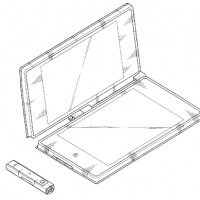
One screen good, two screens better. That seems to be the thinking behind one of Samsung’s latest awarded patent filings, spotted in the USPTO by Forbes. The patent shows a clamshell design not dissimilar to the Sony Tablet P, but using a larger, flatter form factor that’s more like a traditional laptop in shape. Also of note is a removable controller/pointer that slides into a slot along the hinge.
The last detail points to a device aimed squarely at the business class, something that Samsung has yet to do with its tablets. The dual 7-inch screens work separately or in tandem. Thoughts of a dedicated screen for a projector view and one for presentation management seem like a natural extension with the pointer, though it could be something a little more boring, like having a dedicated screen used mostly for displaying the keyboard.
This is hardly the first time we’ve seen a dual-screen design for Android. Among less commercial examples there’s the Kyocera Echo, which didn’t turn out so well. It must be said that there’s no guarantee that the patent points towards an Android device – dual-screen Windows laptops aren’t unheard of either. In any case, we’ve seen no indication that a “Galaxy Tab Dual” is coming down the pipe any time soon, but a guy can dream.













The Toshiba Libretto got mighty close to succeeding using a dual screen with windows 7 but they totally blew it by having a useless battery life and a massive price point. If the Libretto dual screen had a far better battery and a much lower price it would of be a super success. Toshiba had the right idea they just let greed and ignorance mess it up.
The dual screens are very cool, but seems more of a extra device most people won’t need.
What else does the patent describe? You can’t exactly patent 2 screens and a presentation pointer, since both of those things have already been done, not just once in the distant dark past, but several times. All of these companies are just patenting things for the sake of it, in a system that allows anything, as long as you can stump up the cash. Which leaves real inventors and innovators struggling to keep up…..